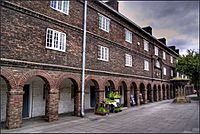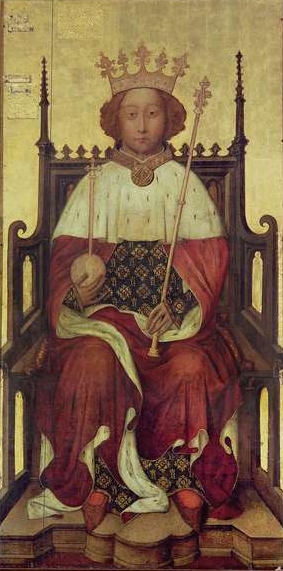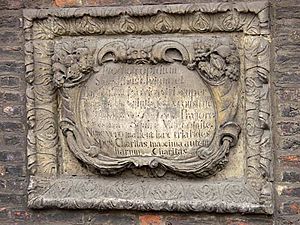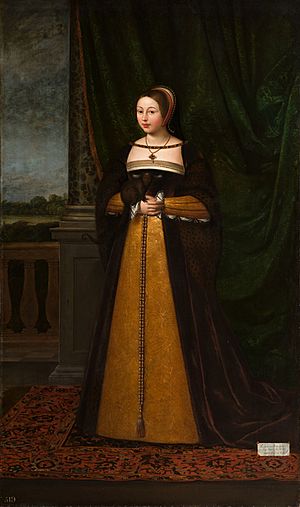Holy Jesus Hospital facts for kids

Front of the Holy Jesus Hospital by David Ord
|
|
| Established | 2000 (in current form, see article) |
|---|---|
| Location | Newcastle upon Tyne |
| Type | Almshouse |
The Holy Jesus Hospital is a historic building in Newcastle upon Tyne, England. It is looked after by the National Trust. Today, it is used as an office. This building is very old and special, listed as a Grade II* building.
For over 700 years, this place has helped the people of Newcastle. First, it was a monastery for Augustinian friars. Later, it became an almshouse, a place where retired people could live. In the 1800s, a soup kitchen was added. Now, it is a working office and home to the National Trust's Inner City Project. This project helps young people (12-25) and older adults (over 50) explore the countryside.
The building is interesting because it still has parts from many different centuries. You can see a wall from the 1300s and a tower from the 1500s. It is also one of only two brick buildings from the 1600s still standing in Newcastle.
Contents
A Monastery for Friars (1291–1539)
In the 1200s, about 4,000 people lived in Newcastle upon Tyne. The four local churches found it hard to help everyone. Priests were teachers, doctors, and counselors, as well as spiritual guides. So, in 1291, William Baron of Wark on Tweed gave land to build an Augustinian priory. This was a type of monastery.
The Augustinian Friars were a group of religious men. They came to England in 1250. They helped communities by preaching and healing. The priory in Newcastle also offered lodging for travelers. It was on a main road leading north. Kings sometimes stayed there. For example, King Edward I visited in 1299.

In 1306, the King gave the monastery more land for a burial ground. Later, King Richard II ordered people to stop dumping trash near the priory. People were throwing "filth, and garbage" near the friars' home. This caused a lot of trouble and danger for them.
Some historians believe English kings used the site even before the priory. After monasteries were closed, the site was used as a temporary base for the King's Council of the North.
When Monasteries Closed (1539)

In 1539, the priory was taken over by the King. This was part of a bigger event called the Dissolution of the Monasteries. At that time, the priory had seven friars and three new members. The religious people were given money or new jobs. The priory's bells, lead, and special clothes were given to the King. Most of the buildings and land were sold.
In 1537, people asked if the priory could be saved. They wanted it to be the northern office for the King's Council of the North. It was not used for this purpose very often. Elizabeth I later said the council should meet there 20 days a year.
By 1595, the building was in poor condition. During the English Civil War, the city council took ownership. The area became known as Kings Manor. Today, only a small part of the priory's wall remains. A model inside the building shows what the friary might have looked like.
The Tower
The tower was built sometime between the closing of the monasteries and the early 1600s. Its exact date is unknown. It was likely built as a strong room to store weapons. It could also be a safe place if the city walls were broken. The ground floor room was used as a temporary jail for people who caused trouble. The tower has changed a lot over time. Part of the wall is from the 1200s, while another wall and door are from the 1700s.
Private Owners (1605–1646)
In 1605, James I of England gave the tower and priory buildings to George Home, 1st Earl of Dunbar. Home sold some parts of the building. He also took the lead off the roof and sold it. Home died in 1611 without a male heir. So, his titles ended. The land then went to Captain Dykes. The site was owned by the council again by 1646.
The Hospital (1646–1825)
The Holy Jesus Hospital was built in 1681. People donated money to build it. It was meant to house retired Freemen (important citizens), their widows, or unmarried children. Locals often called it the "Freeman's Hospital." On March 26, 1684, it officially became the "Hospital of the Holy Jesus." The Mayor and council of Newcastle set the rules for the hospital.
The building was made using brick, which was a new way to build at the time. It is one of only two brick buildings from the 1600s in Newcastle. To live there, people had to meet certain rules. They had to be locked in their rooms at 9 PM and unlocked at 6 AM. Children were not allowed. Residents also had to go to church every week. Each year, they received free clothes, coal, and sometimes pocket money.
The first master of the hospital was Thomas Lewen. The residents received money every three months. The master received more. By the early 1800s, residents received £13 a year, coal, and clothing. They also met with the Mayor every three months to share any problems.
In 1705, people from the Newcastle House of Correction made purple and grey cloth. This was used for uniforms for the widows living at the Holy Jesus Hospital.
There is a Latin message on the front of the building. It says:
"Hospital for poor people built by the citizens and leaders of Newcastle upon Tyne in the year 1683. Built by Timothy Robson, Mayor, John Squire Sheriff. But now only Faith, Hope, and Charity remain, and the greatest of these is Charity."
In 1646, the council allowed the Barber Surgeons to build their hall next to the hospital. They had to build it within two years. Part of the land was to be a garden for medicinal herbs.
The 1800s and a Soup Kitchen
Today, the Holy Jesus Hospital is surrounded by modern roads. But in 1827, it was in a more open area. It was described as a nice brick building with a pleasant walk in front. It had 42 rooms, each with a small coal-house.
A soup kitchen was built next to the hospital in 1880. It replaced a police station. This kitchen gave soup to the 'deserving poor' until 1891. The soup was not free; it cost half a penny per pint. People who donated money received tickets. They could give these tickets to those they thought deserved the soup. The 'deserving poor' were people who could not work in winter.
The soup kitchen was open from December to March, seven days a week. Advertisements asked for donations to pay staff and buy food. Important people from the town ran the kitchen.
Lynn Redhead, who works at the Holy Jesus Hospital, described the kitchen: "People wanting soup came in through a narrow corridor. They were served from large troughs. Nine copper boilers on the first floor made 100 gallons of soup at a time. That's enough for 800 people!"
From 1881, the Discharged Prisoner's Aid Society used the building for laundry work. This was for women who had just left prison. In 1882-1883, City Road was built over the hospital's front lawn.
The soup kitchen closed in 1891. The building was then leased to a butcher. Later, Urwins Chemical Factory operated there from 1913 to 1961. In 1937, the council decided the hospital was not healthy enough for people to live in. A new hospital was built at Spital Tongues. Some original parts of the building were moved there.
The People's Kitchen
The old soup kitchen inspired 'The People's Kitchen'. This is a modern charity that helps homeless people in Newcastle. It was started by Alison Kay. She wanted to help after finding a homeless man who had died. She began by giving tea and sandwiches to homeless men. Then, she started The People's Kitchen. It moved to Bath Lane in 1997 and gives clothes and equipment to homeless people.
The First Museum (1950–1993)
In the late 1960s, people wanted more museums in Newcastle. They thought the Holy Jesus Hospital would be a good spot. The building had been empty for many years and was in bad shape. It cost £67,000 to fix it up. A new roof was needed.
In 1971, the John George Joicey Museum opened. The old soup kitchens were joined to the hospital. The museum taught about Newcastle's history, from Roman times to the present. It had rooms showing how people lived in different periods. Many items were donated by John George Joicey, a businessman.
The tower of the hospital had displays of armor and swords. The Shotley Bridge Sword makers were German sword makers who settled in Durham in 1690. The soup kitchen area was used as a Victorian schoolroom. Children could dress up and learn like Victorian kids. There were also videos about the Tyne Flood of 1771 and the Great Fire of 1854.
The museum was hard to reach because of the city's roads and underpasses. Not many people visited. In 1993, the museum closed. All the items were moved to the Discovery Museum. This included a statue of a knight from the 1400s.
The Inner City Project (2000)
Since 2000, the Holy Jesus Hospital has been the home of the National Trust's Inner City Project. By 2004, £800,000 had been spent to fix up the building. Money came from the Heritage Lottery Fund.
The project started in 1987. It works with young people (12-25) and older adults (over 50). It takes them on trips to the countryside. The National Trust needed a central office to expand this work. So, they agreed to rent the building for 25 years. The Exhibition Room has touch screens and 3D models. These help teach people about the building's history of helping the community.
Some people have praised the Inner City Project. They say it helps connect city people with nature. It also helps people feel more included in society.
Famous Visitors to the Site
- Princess Margaret Tudor – She was the daughter of King Henry VII. She stayed here for four days in 1503. She was traveling north to marry James IV of Scotland.
- Thomas Howard, 4th Duke of Norfolk – He stayed here in 1560. A lot of money was spent to repair the building for his visit. Walls were fixed, the roof was repaired, and a dining room was made larger.
- Eric XIV of Sweden – He visited in 1561. The Great Hall was painted white and decorated with borrowed tapestries for his visit.
See also






